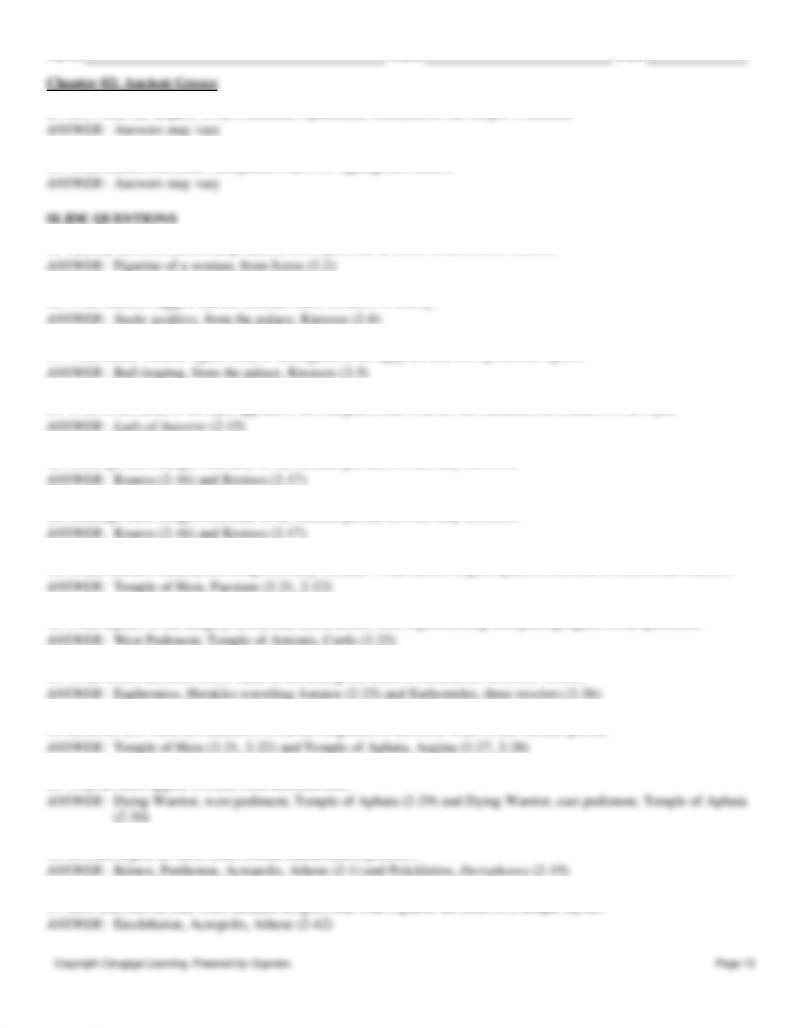
Name:
Class:
Date:
Chapter 02: Ancient Greece
Multiple Choice
1. The dimensions of the Parthenon were calculated on _____.
a.
the Temple of Athena Nike
b.
a fixed proportional scheme
c.
the dimensions of earlier temples
d.
theater designs
2. Along with the patron goddess of Athens, Athena, the Parthenon celebrated the _____.
a.
Olympian deities
b.
Spartans
c.
Macedonians
d.
Athenian people
3. _____ was the sculptor who designed the reliefs and sculptures for the Parthenon.
a.
Phidias
b.
Exekias
c.
Epigonos
d.
Hegeso
4. The Greeks created the concept of _____, or rule by the people.
a.
polis
b.
a canon
c.
democracy
d.
Hellenic
5. _____ did not play a role in public or political life, but were confined to the home.
a.
Philosophers
b.
Athenian leaders
c.
Land-holding males
d.
Greek women
6. Minoan art takes its name from _____.
a.
a Minoan city
b.
the legendary King Minos
c.
the Homeric epics
d.
Socrates

Name:
Class:
Date:
7. The earliest dated Aegean artworks came from _____.
a.
the Cyclades
b.
Tiryns
c.
Athens
d.
Crete
8. Most early Cycladic sculptures represent _____.
a.
bison
b.
males
c.
women
d.
composite creatures
9. Cycladic figures, such as the woman from Syros, are rendered _____.
a.
with bulbous circular forms
b.
naturalistically
c.
as portraits
d.
in a highly schematic manner
10. The _____ was the central feature of the palace at Knossos.
a.
fortifications wall
b.
large rectangular court
c.
outdoor theater
d.
entrance gate
11. _____ provided illumination and ventilation in the palace at Knossos.
a.
Light and air wells
b.
Corbeled vaults
c.
A timber framework
d.
The Lion Gate
12. The construction of _____ characterize the building efforts on Crete in the early centuries of the second millennium.
a.
theaters
b.
beehive tombs
c.
architectural complexes
d.
cyclopean masonry walls
13. Well-preserved Minoan frescoes were found at _____.
a.
Sparta

Name:
Class:
Date:
Chapter 02: Ancient Greece
b.
Athens
c.
Tiryns
d.
Akrotiri
14. Minoan columns are distinguished by a _____.
a.
tapering shape and bulbous capitals
b.
pronounced swelling in the center
c.
bud-shaped capitals
d.
bull-shaped capitals
15. Minoan painting introduced the first _____.
a.
battle scene
b.
pure landscape
c.
representations of animals
d.
ruler portraits
16. Why do some scholars believe Snake Goddess is a deity?
a.
She displays power over animals.
b.
She wears the Minoan goddess dress.
c.
She is posed frontally.
d.
She was found in a temple.
17. The use of dark silhouettes against a cream-colored background typifies the decoration of _____ ceramic pots.
a.
Greek red-figure
b.
Minoan
c.
Mycenaean
d.
Cycladic
18. The positioning of the feet of the figurine of a woman from Syros suggests that it must have been placed lying down
in a _____.
a.
home
b.
grave
c.
cave
d.
citadel
19. Mycenaean citadels, such as those at Mycenae and Tiryns, we famous in antiquity for their _____.
a.
murals
b.
towers

Name:
Class:
Date:
Chapter 02: Ancient Greece
c.
fortification walls
d.
domes
20. Mycenaean masonry is called Cyclopean because of its _____.
a.
color
b.
size
c.
texture
d.
pattern
21. The tholos at Mycenae was a _____.
a.
throne room
b.
temple
c.
treasury
d.
tomb chamber
22. The Mycenaean funerary mask was one of the first attempts at _____ by Greek artists.
a.
a life-sized human face
b.
repoussé
c.
rendering the human face
d.
metalwork
23. At the time of the Trojan wars, wealthy Mycenaeans were buried in _____.
a.
ceramic urns
b.
sarcophagi
c.
tholos tombs
d.
shaft graves
24. _____ were among the artifacts found in the shaft graves at Grave Circle A.
a.
statues of deities
b.
ceramic vessels
c.
lyres
d.
beaten gold masks
25. Cantilevered rows of stone formed a _____ above the lintel of the Lion Gate at Mycenae.
a.
corbeled arch
b.
barrel vault
c.
pattern of vines
d.
ogee

Name:
Class:
Date:
Chapter 02: Ancient Greece
26. The so-called Archaic smile likely signified _____.
a.
life
b.
joy
c.
personality
d.
perfection
27. Greek temples reveal the influence of _____.
a.
Minoan palace plans
b.
Neolithic shrines
c.
Egyptian columnar halls
d.
Persian citadels
28. Which sculpture employs contrapposto?
a.
Kroisos
b.
Kritios Boy
c.
Lady of Auxerre
d.
Peplos Kore
29. Which Athenian politician reconstructed the Athenian Acropolis?
a.
Pausanius
b.
Polykleitos
c.
Xerxes
d.
Pericles
30. How is the Parthenon imperfect?
a.
The columns are not perpendicular to the ground.
b.
The pediments are not triangular.
c.
The cella is not square.
d.
The stylobate is not straight.
31. Following the Peloponnesian war and the alienation and disillusionment that followed, Late Classical artists focused
on _____.
a.
community values
b.
mathematical perfection
c.
real-world appearances
d.
Polykleitos’s Canon

Name:
Class:
Date:
32. The Altar of Zeus celebrates the _____.
a.
victory of Attalos I over the Gauls
b.
life of Alexander the Great
c.
birth of Zeus
d.
lapiths’ defeat of the centaurs
33. The depopulation and poverty that followed the fall of the Mycenaeans is called the _____.
a.
Doric period
b.
Dark Age of Greece
c.
Golden Age of the Minoans
d.
Hellenistic era
34. Greek vase painting of the _____ consisted mainly of abstract motifs.
a.
Geometric age
b.
Orienalizing period
c.
Hellenistic age
d.
Pergamenes
35. The early Greek style of representing statues with triangular heads and is called the _____ style.
a.
canon
b.
Kroisos
c.
daedelic
d.
Doryphoros
36. _____ strongly influenced the pose of early Greek kouros figures.
a.
Minoan portraits
b.
Egyptian statues
c.
Persian art
d.
Snake goddesses
37. One of the primary purposes for temples was to house an image of a deity called _____.
a.
an atlantid
b.
a caryatid
c.
a kouros
d.
a cult statue
38. In the Archaic period, ceramic painters introduced a new painting technique called _____.

Name:
Class:
Date:
Chapter 02: Ancient Greece
a.
white-ground painting
b.
kamares ware
c.
black-figure painting
d.
the Orientalizing style
39. _____ was the master of the black-figure technique.
a.
Philoxenos of Eretria
b.
Exekias
c.
Kroisos
d.
Daedelus
40. The defeat of the Persians is the historical event that marked the beginning of the _____ age.
a.
classical
b.
Minoan
c.
Hellenistic
d.
Dark
41. Classical statues departed from the Archaic by abandoning _____.
a.
painted features
b.
the Egyptian pose
c.
naturalism
d.
nudity
42. Large bronze sculptures were created using the _____ technique.
a.
bas relief
b.
reduction
c.
cloisonné
d.
lost wax
43. Polykleitos created the _____ to accompany a treatise on the ideal statue of a nude male warrior or athlete.
a.
Dying Gaul
b.
Centauromachy
c.
Doryphoros
d.
Dying Warrior
44. Funds from the _____ were used to finance Pericles’s rebuilding of the Akropolis.
a.
Delian League
b.
Peloponnesian war

Name:
Class:
Date:
Chapter 02: Ancient Greece
c.
Battle of Actium
d.
Athenian senate
45. The fusion of Doric and Ionic elements in the Parthenon may reflect the Athenian belief that _____.
a.
Persia would invade Greece
b.
they were the leaders of the Greeks
c.
eastern Greeks were superior architects
d.
there should be a new Greek order
46. The artist Phidias treated the floor of the Parthenon’s pediment as _____.
a.
an imitation of the Temple of Aphaia at Aegina
b.
a ground line for life-size figures
c.
a horizon line through which figures could pass
d.
a shallow ledge supporting relief sculptures
47. The subject of the Parthhenon’s Ionic frieze is the _____.
a.
extinction of the Amazons
b.
battle between the gods and giants
c.
the Persian war
d.
Panathenaic procession
48. The irregular form of the Erectheion was necessitated by its _____.
a.
function of housing several sacred sites
b.
dedication to Zeus and Hera
c.
placement next to the Parthenon
d.
multistory form
49. On the Stele of Hegeso, the deceased is represented ______.
a.
teaching her children
b.
taking leave of her husband
c.
with her parents
d.
in a domestic setting
50. The white-ground technique was used almost exclusively on _____.
a.
amphora
b.
kraters
c.
lekythoi
d.
mosaic pavements

Name:
Class:
Date:
Chapter 02: Ancient Greece
51. _____ took the unprecedented step of representing the goddess Aphrodite nude.
a.
Epigonos
b.
Praxiteles
c.
Euphronios
d.
Lysippos
52. The cultural centers of the Hellenistic period were _____.
a.
court cities of Alexander’s successor
b.
Athens and Sparta
c.
Macedonia
d.
Greek colonies in Italy
53. Unlike their Early Classical predecessors, Late Classical artists focused on _____.
a.
community values
b.
mathematical perfection
c.
real-world appearances
d.
Polykleitos’s canon
54. Unlike Classical sculptors, Hellenistic artists created _____.
a.
monumental images
b.
a variety of physical types
c.
idealized figures
d.
relief and full-round sculpture
55. (Figure 2-7)
a.
Cycladic
b.
Minoan
c.
Assyrian
d.
Mycenaean
56. (Figure 2-9)
a.
Tiryns
b.
Knossos
c.
Athens
d.
Mycenae

Name:
Class:
Date:
Chapter 02: Ancient Greece
57. (Figure 2-1)
a.
Erechtheion
b.
Temple of Athena Nike
c.
Parthenon
d.
Temple of Hera
58. (Figure 2-35)
a.
Charioteer
b.
Diskobolos
c.
Doryphoros
d.
Apoxyomenos
59. (Figure 2-2)
a.
Cycladic
b.
Minoan
c.
Mycenaean
d.
Helladic
60. (Figure 2-5)
a.
Chalk
b.
Oil
c.
Fresco secco
d.
True fresco
61. (Figure 2-18)
a.
Peplos Kore
b.
Lady of Auxerre
c.
Kouros
d.
Athena
62. (Figure 2-59)
a.
Pericles
b.
Odysseus
c.
Herakles
d.
Laocoön

Name:
Class:
Date:
63. (Figure 2-21)
a.
Temple of Aphaia
b.
Temple of Hera, Paestum
c.
Porch of Maidens, Erechtheion
d.
Temple of Athena Nike
64. (Figure 2-32)
a.
Charioteer
b.
Diskobolos
c.
Doryphoros
d.
Apoxyomenos
65. (Figure 2-13)
a.
Minoan
b.
Mycenaean
c.
Geometric Greek
d.
Archaic Greek
66. (Figure 2-34a)
a.
Apollo
b.
Herakles
c.
Charioteer
d.
Kritios Boy
67. (Figure 2-42)
a.
Erechtheion
b.
Propylaia
c.
Parthenon
d.
Temple Athena Nike
68. (Figure 2-54)
a.
Dying Greek
b.
Dying Gaul
c.
Dying Athenian
d.
Dying Roman
69. (Figure 2-40)
a.
Parthenon, Acropolis

Name:
Class:
Date:
Chapter 02: Ancient Greece
b.
Temple of Zeus, Olympia
c.
Temple of Aphaia, Aegina
d.
Temple of Athena Nike, Acropolis
70. What made the Parthenon a “perfect temple”?
71. How do the themes portrayed on the Parthenon sculptures and reliefs allude to the Greek victory over the Persians?
72. Describe how the civilizations of the Aegean are named.
73. Describe the possible functions served by the architectural complexes on Crete.
74. What are some of the characteristic architectural features of the palace at Knossos?
75. Describe the relationship between Mycenaean funerary masks and Egyptian art.
76. How were Geometric vases, such as the funerary krater, decorated?
77. Why does the Geometric krater mark a turning point in the history of Greek art?
78. What are the characteristics of the daedelic style in early Archaic sculpture?
79. Identify the primary differences between the Doric and Ionic orders.
80. Where did Greeks typically place architectural sculpture?
81. Describe Exekias’s skill as a black-figure painter.
82. Which Ionic features appear on the Parthenon, and what theories explain why the Doric and Ionic orders were blended
in this building?

Name:
Class:
Date:
83. How were the subjects of the Parthenon’s pediments connected to the temple’s function?
84. What reasons did Greek vase painters have for signing their names?
85. Identify the civilization that produced this object, and describe its distinctive features.
86. What features suggest that the Minoan Snake Goddess is a deity?
87. What makes Minoan figures easy to distinguish from Egyptian and Mesopotamian figures?
88. What is the name of the style applied to this sculpture, and what are the characteristic features of this style?
89. Although these images both date to the Archaic period, how are they different?
90. Although these images both date to the Archaic period, how are they different?
91. Which features identify this temple as early Archaic? What factors might explain its unusual or transitional features?
92. What aspects of the imagery reveal that Greek artists were experimenting with placing figures in the pediment?
93. What strides did these artists make in increasing the sense of illusionism on Greek vessels?
94. Describe how these are indicative of the development of the Doric order in the Archaic period.
95. Why do these appear to come from different eras?
96. In what respect do these share similar mathematical pursuits?
97. How does this deviate from standard temples, and what explains the need for a unique layout?

Name:
Class:
Date:
98. What significant break did this make from the Archaic period?
99. Which new features did this artist introduce to the sculpted male form?
100. What does this monument reveal about ancient Greek society and gender roles?
101. Which newfound interest in the Hellenistic period does this work exemplify?
102. What aspects did the artist of this work carefully observe?
103. What is the function of this building? What purposes did the different parts of the building serve?
104. Which characteristics that appear here have no parallel in earlier art?
105. Compare and contrast the dominant architectural features of the Minoan palace at Knossos and the Mycenaean
citadels. What do the differences reveal about their respective societies?
106. Both the Palace at Knossos and houses at Akrotiri are adorned with mural paintings. What are the distinctive stylistic
features of Minoan art? What new themes did Minoan artists explore?
107. Citing specific examples explain how Mycenaean monuments’ art objects promote the power of the king.
108. Discuss the changes in vase painting from the Geometric period to the Classical era in Greece. Consider the manner
in which artists treated the surface and the techniques employed. Please provide examples.
109. Citing specific examples examine the development of the male figure in Greek sculpture from the Archaic to the
Classical period.
110. How did Hellenistic sculpture deviate from the Classical period? Please provide examples.
111. Describe the three different vase painting techniques used from the Archaic to the Classical periods. What were the
advantages of each?

Name:
Class:
Date:
112. Describe the development of the Doric order in temple architecture. How did it change from the Archaic to the
Classical period?
113. What did the sculptors Lysippos and Praxiteles contribute in the Late Classical period of sculpture?
114. How did the female form develop from the Archaic to the Hellenistic period? Please provide examples.
115. Attribute the images on the screen to a culture and give an approximate date. Give the reasons for your attributions,
using complete sentences and referring to specific works discussed in class.
2. Another Archaic kouros figure possibly the Argive Twins (Kleobis and Biton) or Sounion kouros.
3. Detail of frieze from the Siphnian Treasury.
4. Another fifth-century Classical female figure, possibly Athena.
5. Another Hellenistic sculpture, possibly another old woman or young child.